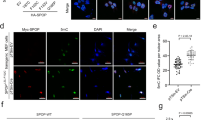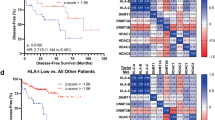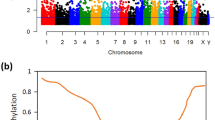Abstract
14-3-3σ proteins regulate numerous cellular processes that are important to cancer development. One of its biological roles involves G2 cell-cycle arrest following DNA damage. It has also been reported that the loss of 14-3-3σ expression via CpG methylation may contribute to malignant transformation by impairing the G2 cell-cycle checkpoint function, thereby allowing an accumulation of genetic defects. However, how the CpG methylation-dependent silencing mechanism works in relation to promoter methylation associated with methyl-CpG-binding proteins (MeCPs) is still unclear. To better understand the mechanism, we first examined the methylation status of the 14-3-3σ promoter-associated CpG islands and 14-3-3σ gene expression in a subset of prostate cancer cell lines using methylation-specific PCR (MSP), an HhaI-based DNA methylation assay, and reverse transcription–PCR (RT–PCR). We found that the 14-3-3σ expression is lost in LNCaP and Tramp-C1 prostate cancer cell lines and that this expression is restored after treatment with epigenetic silencing modifiers 5-aza-2′-deoxycytidine (5-aza) and trichostatin A (TSA). These results imply transcriptional silencing via promoter-associated CpG methylation. Chromatin immunoprecipitation analysis revealed that methyl-CpG-binding protein 2 (MBD2) is associated preferentially to the methylated CpG island in the 14-3-3σ promoter in LNCaP and Tramp-C1 cells but not in 14-3-3σ-expressing PC3 and DU145 cells, which contain an unmethylated CpG island in the 14-3-3σ promoter region. The 14-3-3σ gene silencing because of CpG methylation correlates with binding of MBD2. In addition, the activation of 14-3-3σ gene expression by a combination of 5-aza and TSA also involves the release of the MBD2 from the 14-3-3σ promoter-methylated CpG island in LNCaP and Tramp-C1 cells. Furthermore, MBD2 knockdown by siRNA stimulated 14-3-3σ expression in LNCaP cells. We also investigated whether the loss of 14-3-3σ expression in LNCaP and Tramp-C1 cells affects cell proliferation by MTT assays. Interestingly, we observed that 14-3-3σ-inactivated LNCaP and Tramp-C1 cells had markedly decreased cell proliferation and protein expression of proliferation cell nuclear antigen (PCNA) after restoration of 14-3-3σ expression with 5-aza and TSA treatment. On the other hand, the same treatment did not significantly affect 14-3-3σ-active PC3 and DU145 cells, which normally express 14-3-3σ. Finally, 14-3-3σ knockdown by siRNA resulted in increased proliferation in PC3 and DU145 cells. These findings suggest that the transcriptional silencing of the 14-3-3σ gene is caused by promoter CpG island methylation associated with MBD2, and that this may play an important role in prostate cancer progression during the invasive and metastatic stages of the disease.
This is a preview of subscription content, access via your institution
Access options
Subscribe to this journal
Receive 50 print issues and online access
$259.00 per year
only $5.18 per issue
Buy this article
- Purchase on Springer Link
- Instant access to full article PDF
Prices may be subject to local taxes which are calculated during checkout







Similar content being viewed by others
Accession codes
Accessions
GenBank/EMBL/DDBJ
Abbreviations
- ChIP:
-
chromoatin immunoprecipitation
- HDAC:
-
histone deacetylase
- MBD2 :
-
methyl-CpG-binding protein 2
- MSP:
-
methylation-specific PCR
- RNAi:
-
RNA interference
- siRNA:
-
small-interfering RNA
- 5-aza:
-
5-aza-2′-deoxycytidine
- TSA:
-
trichostatin A
- RT:
-
reverse transcription
- TPBS:
-
Tween-20 (0.1%) phospate-buffered saline
- PBS:
-
phospate-buffered saline
- PIN:
-
prostatic intraepithelial neoplasia
- BSA:
-
bovine serum albumin
References
Baylin SB, Herman JG . (2000). Trends Genet 16: 168–174.
Bird A . (2002). Genes Dev 16: 6–21.
Bird AP, Wolffe AP . (1999). Cell 99: 451–454.
Chan TA, Hermeking H, Lengauer C, Kinzler KW, Vogelstein B . (1999). Nature 401: 616–620.
Cheng L, Pan CX, Zhang JT, Zhang S, Kinch MS, Li L et al. (2004). Clin Cancer Res 10: 3064–3068.
Darwanto A, Kitazawa R, Maeda S, Kitazawa S . (2003). Cancer Sci 94: 442–447.
De Smet C, Loriot A, Boon T . (2004). Mol Cell Biol 24: 4781–4790.
Dougherty MK, Morrison DK . (2004). J Cell Sci 117: 1875–1884.
Ego T, Tanaka Y, Shimotohno K . (2005). Oncogene 24: 1914–1923.
Esteller M . (2005). Annu Rev Pharmacol Toxicol 45: 629–656.
Esteller M, Risques RA, Toyota M, Capella G, Moreno V, Peinado MA et al. (2001). Cancer Res 61: 4689–4692.
Ferguson AT, Evron E, Umbricht CB, Pandita TK, Chan TA, Hermeking H et al. (2000). Proc Natl Acad Sci USA 97: 6049–6054.
Fraga MF, Ballestar E, Villar-Garea A, Boix-Chornet M, Espada J, Schotta G et al. (2005). Nat Genet 37: 391–400.
Frommer M, McDonald LE, Millar DS, Collis CM, Watt F, Grigg GW et al. (1992). Proc Natl Acad Sci USA 89: 1827–1831.
Fu H, Subramanian RR, Masters SC . (2000). Annu Rev Pharmacol Toxicol 40: 617–647.
Fujita N, Takebayashi S, Okumura K, Kudo S, Chiba T, Saya H et al. (1999). Mol Cell Biol 19: 6415–6426.
Galm O, Suzuki H, Akiyama Y, Esteller M, Brock MV, Osieka R et al. (2005). Oncogene 24: 4799–4805.
Goodman PA, Burkhardt N, Juran B, Tibbles HE, Uckun FM . (2003). Oncogene 22: 2504–2514.
Hermeking H . (2003). Nat Rev Cancer 3: 931–943.
Iwata N, Yamamoto H, Sasaki S, Itoh F, Suzuki H, Kikuchi T et al. (2000). Oncogene 19: 5298–5302.
Jenuwein T, Allis CD . (2001). Science 293: 1074–1080.
Jones PA . (1999). Trends Genet 15: 34–37.
Jones PA, Baylin SB . (2002). Nat Rev Genet 3: 415–428.
Jones PA, Laird PW . (1999). Nat Genet 21: 163–167.
Kaneuchi M, Sasaki M, Tanaka Y, Shiina H, Verma M, Ebina Y et al. (2004). Biochem Biophys Res Commun 316: 1156–1162.
Kitazawa S, Kitazawa R, Maeda S . (1999). J Biol Chem 274: 28787–28793.
Konduri SD, Srivenugopal KS, Yanamandra N, Dinh DH, Olivero WC, Gujrati M et al. (2003). Oncogene 22: 4509–4516.
Lin X, Nelson WG . (2003). Cancer Res 63: 498–504.
Lodygin D, Diebold J, Hermeking H . (2004). Oncogene 23: 9034–9041.
Lodygin D, Hermeking H . (2005). Cell Res 15: 237–246.
Lodygin D, Yazdi AS, Sander CA, Herzinger T, Hermeking H . (2003). Oncogene 22: 5519–5524.
McKie AB, Douglas DA, Olijslagers S, Graham J, Omar MM, Heer R et al. (2005). Oncogene 24: 2166–2174.
Mhawech P . (2005). Cell Res 15: 228–236.
Mhawech P, Benz A, Cerato C, Greloz V, Assaly M, Desmond JC et al. (2005). Mod Pathol 18: 340–348.
Muslin AJ, Xing H . (2000). Cell Signal 12: 703–709.
Nakagawachi T, Soejima H, Urano T, Zhao W, Higashimoto K, Satoh Y et al. (2003). Oncogene 22: 8835–8844.
Nguyen CT, Gonzales FA, Jones PA . (2001). Nucleic Acids Res 29: 4598–4606.
Osada H, Tatematsu Y, Yatabe Y, Nakagawa T, Konishi H, Harano T et al. (2002). Oncogene 21: 2418–2424.
Pakneshan P, Szyf M, Farias-Eisner R, Rabbani SA . (2004). J Biol Chem 279: 31735–31744.
Pakneshan P, Xing RH, Rabbani SA . (2003). FASEB J 17: 1081–1088.
Park J, Song SH, Kim TY, Choi MC, Jong HS, Kim TY et al. (2004). Oncogene 23: 3474–3480.
Patra SK, Patra A, Zhao H, Carroll P, Dahiya R . (2003). Biochem Biophys Res Commun 302: 759–766.
Reichelt J, Magin TM . (2002). J Cell Sci 115: 2639–2650.
Santini V, Kantarjian HM, Issa JP . (2001). Ann Intern Med 134: 573–586.
Sharma D, Blum J, Yang X, Beaulieu N, Macleod AR, Davidson NE . (2005). Mol Endocrinol 19: 1740–1751.
Singal R, Ginder GD . (1999). Blood 93: 4059–4070.
Singal R, van Wert J, Bashambu M . (2001). Cancer Res 61: 4820–4826.
Stirzaker C, Song JZ, Davidson B, Clark SJ . (2004). Cancer Res 64: 3871–3877.
Tanaka K, Hatada T, Kobayashi M, Mohri Y, Tonouchi H, Miki C et al. (2004). Int J Oncol 25: 1591–1597.
Tate PH, Bird AP . (1993). Curr Opin Genet Dev 3: 226–231.
Tzivion G, Avruch J . (2002). J Biol Chem 277: 3061–3064.
Tzivion G, Shen YH, Zhu J . (2001). Oncogene 20: 6331–6338.
Urano T, Takahashi S, Suzuki T, Fujimura T, Fujita M, Kumagai J et al. (2004). Biochem Biophys Res Commun 319: 795–800.
Woodcock JM, Murphy J, Stomski FC, Berndt MC, Lopez AF . (2003). J Biol Chem 278: 36323–36327.
Yatabe Y, Osada H, Tatematsu Y, Mitsudomi T, Takahashi T . (2002). Oncogene 21: 8310–8319.
Yu F, Thiesen J, Stratling WH . (2000). Nucleic Acids Res 28: 2201–2206.
Zhang Y, Karas M, Zhao H, Yakar S, LeRoith D . (2004). J Biol Chem 279: 34353–34360.
Acknowledgements
We thank Shellee Abraham for preparing the manuscript and Diana Meister and Sushma Jasti for the manuscript review. This research was supported by National Cancer Institute Grant CA 75557, CA 92393, CA 95058, CA 116708 and NINDS NS47699 and Caterpillar, Inc., OSF Saint Francis Medical Center, Peoria, IL (to JSR).
Author information
Authors and Affiliations
Corresponding author
Rights and permissions
About this article
Cite this article
Pulukuri, S., Rao, J. CpG island promoter methylation and silencing of 14-3-3σ gene expression in LNCaP and Tramp-C1 prostate cancer cell lines is associated with methyl-CpG-binding protein MBD2. Oncogene 25, 4559–4572 (2006). https://doi.org/10.1038/sj.onc.1209462
Received:
Revised:
Accepted:
Published:
Issue Date:
DOI: https://doi.org/10.1038/sj.onc.1209462
Keywords
This article is cited by
-
Methylation as a critical epigenetic process during tumor progressions among Iranian population: an overview
Genes and Environment (2021)
-
Using a machine learning approach to identify key prognostic molecules for esophageal squamous cell carcinoma
BMC Cancer (2021)
-
Targeting epigenetic regulators for cancer therapy: mechanisms and advances in clinical trials
Signal Transduction and Targeted Therapy (2019)
-
Epigenetic alterations in TRAMP mice: epigenome DNA methylation profiling using MeDIP-seq
Cell & Bioscience (2018)
-
Comparative analysis of 14-3-3 isoform expression and epigenetic alterations in colorectal cancer
BMC Cancer (2015)



